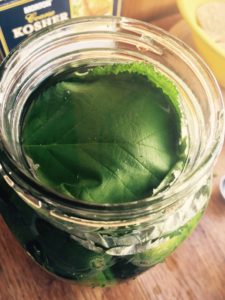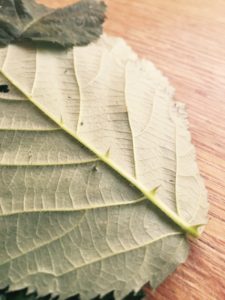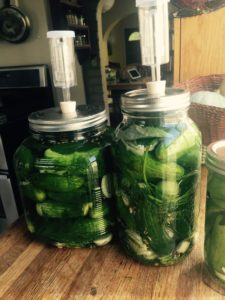
Growing up, I’ve always ate tons of pickles. Delicious, sour, dilly pickles. As I’ve gotten older, I’ve developed a taste for fermented sour pickles. This recipe includes fresh fennel and fresh garlic, an addition that I think makes these pickles unique. I always look for small pickling cucumbers when I’m at the farmer’s market in the early fall or spring and snag up a pound or two when they are around! Small pickling cucumbers never last long at the market.
This recipe also includes the inclusion of tannic leaves to create a crisp pickle. When I was living in Berkeley, we had tons of blackberry bushes growing in our yard, so I was able to grab a handful of those, being careful to remove the prickers on the leaves before using them. After I moved to Chicago, it was more difficult to find blackberry bushes. However, after a quick walk in Logan Square, I was able to find a White Oak tree and have used those instead with similar results.

Some reminders/tips:
- The addition of blackberry/cherry/grape/oak leaves provides tannins that keep the pickles crunchy, a time-old tradition.
- Soaking the pickles in ice water soak for up to 4 or 5 hours before pickling rehydrates the cucumbers if any water has been lost since they were harvested, helping to ensure that you have a plump juicy and crunchy pickle!
Equipment:
2, 1-gallon glass mason jar or ceramic crock
A breathable cloth cover (layered paper towels are fine)
A fermenting bung, if fermenting in mason jars
Ingredients:
1/2 a gallon of warm water (tap water is fine, but I did use a filter)
2-3 pounds of pickling cucumbers, the smaller the better (this is a personal preference)
1-2 heads of garlic, peeled
6 tablespoons sea salt
10 wildcrafted oak, cherry, grape, or blackberry, or cherry leaves
2 bunches of fresh dill
2 bay leaves
1/2 fennel bulb, sliced into 1/4 inch pieces
1 tsp coriander seed
1 tsp whole peppercorns
1 tsp fennel seed
Directions:
Rinse cucumbers, removing their blossoms are removed by gently rubbing until it easily comes off. If the cucumbers have been sitting in your fridge for several days, or haven’t been recently harvested, soak in a bowl of ice water for several hours. 
Dissolve sea salt in ½ gallon of warm water to create brine solution and stir until dissolved.
Clean the crock or mason jars using soap and hot water or sanitizing solution. If using mason jars, divide the ingredients evenly between each jar. If using a crock or a large vessel, add all ingredients. At the bottom of the jar, add dill, garlic, fennel, bay leaves, a few of the tannic leaves, and the remainder of the herbs.
Tightly pack cucumbers into the crock/jars and pour the brine over the cucumbers. Top with a layer of tannic leaves to prevent the cucumbers from being exposed to air as they ferment and to help the pickles stay submerged.

If using blackberry leaves, don’t forget to remove the prickers on the underside of each leaf.

If using a crock, you can weight down the pickles to make sure the brine covers them using a jug filled with water or a plate. If the brine doesn’t cover the weighed-down plate, add more brine mixed a ratio of approximately 1 tablespoon of salt per cup of water.
Cover the crock with a cloth to keep out dust and flies and store it in a cool place, or place a lid on top with an airlock. I drilled holes into mason jar lids, but there are much easier ways to do this these days, by purchasing pre-made mason jar lids to help you out. These ones through Amazon should work fine.

Check the pickles each day, skimming any mold that forms at the surface as you find it or cleaning it off of weights you have used so that it doesn’t continue to spread. After a few days, taste the pickles and keep checking the crock every day until the desired consistency/flavor is achieved. I like a full sour pickle, which can take up to four weeks, depending on the temperature in the room.
Once the pickles reach your desired tangy-ness, replace lids (or put in mason jars if using a crock) and store in the fridge to the slow down fermentation. Pickles can last up to two years in the fridge, but there’s no way these will last that long!